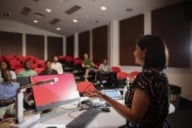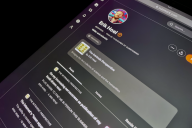You have /5 articles left.
Sign up for a free account or log in.
BOSTON — In recent years, big conversations at and about the annual meeting of the Modern Language Association have been driven by two major and ongoing forces of change: the increasingly bleak economic realities of the profession (and particularly the shift of jobs away from the tenure track) and the ways that new technologies are transforming scholarly work in the humanities -- and scholarly communications in general.
At a panel Friday on “Avenues of Access: Digital Humanities and the Future of Scholarly Communication,” outgoing MLA President Michael Bérubé called MLA Executive Director Rosemary Feal “the first director of anything to tweet anything” -- a hyperbolic designation, no doubt, but an indicator of the extent to which Feal has embraced technology and social media as a way to create common ground and to mitigate the organization’s traditionally rigid hierarchies.
In 2011, Feal, along with the MLA’s Executive Council, established a new office of scholarly communication, an expansion of what was previously known as the office of book publications. The scholarly communication office is headed up by Kathleen Fitzpatrick, formerly a professor of media studies at Pomona College, whose academic work has focused on digital media and digital humanities. Fitzpatrick is also the founding editor of MediaCommons, an online network for media studies scholars that aims to help expand and transform the traditional definition of publishing.
Not coincidentally, the office of scholarly communication's first big project is a new online network called MLA Commons, which launched at this year’s convention with some fanfare. MLA Commons is an Internet community for MLA members, combining various functions of social and professional networks like Facebook and LinkedIn; blogging platforms like Blogger and WordPress; and discussion groups like e-mail listservs and online message boards.
Users can add contacts (much like they might add friends on Facebook or colleagues on LinkedIn); publish personal or professional blogs; post articles or other works; and form public or private groups for the discussion of topics such as "Film," "Jewish Cultural Studies," "Teaching as a Profession," "East Asian Languages and Literatures to 1900," and many, many more. (Just a few days after its launch, the site already features several hundred groups on a mind-boggling array of subjects.)
At the session on access and digital humanities, panelist Matthew Kirschenbaum, associate professor of English at the University of Maryland at College Park, explored the history of online academic discourse, contextualizing MLA Commons as the latest in a long and ever-evolving line of such networks going back at least to the 1980s.
Kirschenbaum noted, with much humor, how dated many of those platforms look to us now (“This was 1996. My dearest friends, there was. no. Google. You Yahooed -- there’s no shame, we all did -- or summoned forth the awesome powers of Alta Vista”), emphasizing that MLA Commons, too, will one day be obsolete. “[W]hat should endure,” he said, “are the relationships it fosters and the work thus performed.”
On the subject of those relationships, Kirschenbaum noted that “access always engenders power” -- and he raised the question of the extent to which MLA Commons will end up “replicating existing power dynamics in the profession.”
Those power dynamics, of course, are part of what MLA Commons is intended to alter. Since taking office in 2002, Feal has been pushing toward a bigger-tent MLA, highlighting the challenges and aspirations of graduate students, early-career faculty members, and non-tenure-track faculty to an unprecedented degree.
In an interview, she depicted MLA Commons as one tool in “breaking down the binary” of those on and those off the tenure track -- as well as the binary of Ph.D.s who stay in traditional academe versus those who leave. The crumbling of this latter dichotomy was much in evidence at this year’s MLA, where “alternative academic” -- or “alt-ac” -- careers were a hot topic and the subject of marked optimism.
These days, many such positions, at least for those with literature and language Ph.D.s, are in or related to the digital humanities, panelist Bethany Nowviskie noted at the access and digital humanities session.
But Nowviskie -- who is director of digital research & scholarship at the University of Virginia Library, associate director of the library’s Scholarly Communication Institute, and president of the Association for Computers and the Humanities -- argued that that’s not an unambiguous good. “[D]igital humanities staff already struggle against the pressure to become jacks of all trades and masters of none,” Nowviskie said. “How can grant-funded DH journeymen find the time and feel the stability that leads to institutional commitment, to deep engagement and expertise, and to iterative refinement of their products and research findings?”
As for the ever-growing numbers of contingent teaching faculty, she added, given the considerable challenges they face, “what vanishing minority of those will ever transition from being passive digital tool-users to active humanities makers?”
Panelist Cathy Davidson, Ruth F. DeVarney Professor of English and John Hope Franklin Humanities Institute Professor of Interdisciplinary Studies at Duke University, tackled a different aspect of "access" in her talk, contending that -- in contrast to the current craze for MOOCs, which "massively scal[e] an outmoded model of education" -- academics "should be massively remodeling our institutions for contributive, connected participatory learning."
But Davidson -- herself the founder of HASTAC, a decade-old online and in-person network of scholars and others interested in the transformative potential of new technologies for teaching, learning, communicating, and conducting research -- also argued that the digital humanities are intrinsically connected to ideas about breaking down barriers and undermining hierarchies.
In its early days, Davidson said, "the field was largely, though not exclusively, about digitizing and scaling and making 'available' existing archives. The rhetoric, too, was about access in a fairly narrow conceptual sense: digitizing existing knowledge so more people could use it."
But as their work has grown and evolved, Davidson said, "digital humanists have seen that, once you change access, you open the floodgates to a range of other questions about content, authority, hierarchy, and power that you may not even know you were asking."
By that logic, it is only natural that the MLA (as its individual members and as an organization) is engaging in more and more reflection and discussion on the disparities between tenure-track and other faculty members, the treatment of graduate students, and the power structures of the association itself at the same time that many of its members are embracing and exploring digital humanities and communications.
"I definitely see one of the remits of digital humanities being this question of scholarly communication and how the digital is transforming, not just what the humanities is, but the humanities in the act -- how we communicate what it is we do," Kathleen Fitzpatrick said in an interview.
The new office of scholarly communication, she added, hopes to examine "what the future of communications is within the field in a broad sense -- not just formalized publications like books and journals."
That expanded and evolving definition of "communications" provides an apt analogy for an organization that is simultaneously attempting to offer much more in the way of voice and opportunity to those who have historically felt alienated from its goals and operations. If all goes very well, the same technologies may do much to advance progress on both fronts.








